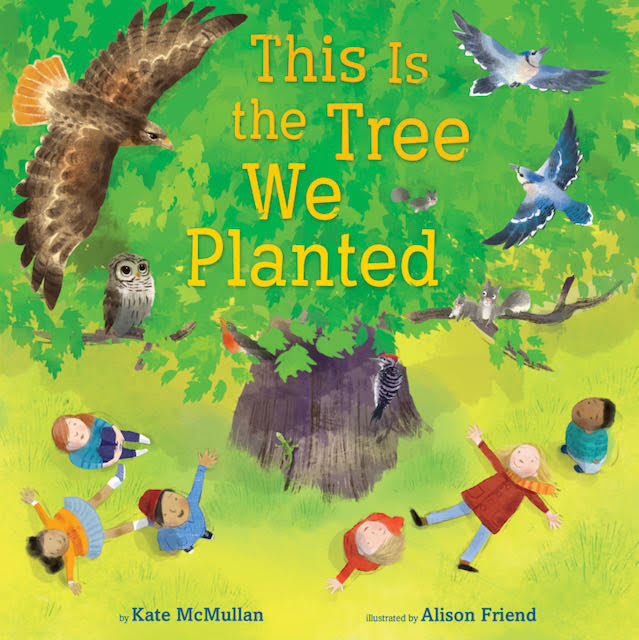This Is the Tree We Planted written by Kate McMullen, illustrated by Alison Friend; Knopf, 2022.
Those of you who share books with me know that I am instantly swept in when the flyleaves of a picture book are thoughtfully, artfully designed. It’s so with this rhythmical picture book celebrating the impact a tree has on its surroundings and those who are fortunate enough to benefit from its myriad gifts. Open the book, turn it sideways, and behold magnificence and boldness in leaf and limb. The experience begins.
To be a Flower,
is profound
Responsibility
~ Emily Dickinson
Why this Book? Why will it matter to kids?
This Is the Tree We Planted is pitch perfect for April, the month when we pay special attention to Earth and its precious bounty, culminating with Earth Day on April 22. From the title page onward, the children in this informational story plant, learn, and grow as they enjoy the gifts the tree offers as it matures and flourishes. Young listeners will collect facts and gain appreciation as they happily follow along in this cumulative, rhyming tale. The text is jaunty and rhythmical, reminiscent of the well-known British nursery rhyme, “This Is the House That Jack Built.” The words of import are capitalized to offer emphasis and ultimately form a list at the end of the story.
Levels and Layers of Learning
Grade level: Pre-K—2
Social-Emotional Learning Themes
Appreciation, concern, connection, creativity, dedication, empathy, encouragement, empowerment, friendship, generosity of spirit, gratitude, helpfulness, hope, inspiration, kindness, perseverance, perspective, resilience, resourcefulness, respect, self-awareness, self-reliance, understanding
Content Area Connections: Science, Environment, Conservation, English Language Arts
Using This Book in the Classroom
Write Away! Ideas to prompt writing
Consider creating a “This Is the Tree We Planted” chain across one side of the room on which the key elements from the book are linked. Next, using the structure of the book, collectively brainstorm elements and then create another chain to depict “This Is the Way We Care for Our Earth.”
Have students create acrostic poems choosing from the words in the list at the end of the book. Post poems on the limbs of a life-size tree in the classroom or hallway.
Describe your favorite tree. Draw a picture of it.
Write about a personal experience in which a tree played a part.
Have you ever climbed a tree? Describe the experience. If you haven’t, imagine what it would be like. What did/would you do once settled among the branches?
Kate suggests, “Students may enjoy keeping a Tree Diary by observing what’s going on in a single tree and writing a sentence or two about it each week throughout the school year.”
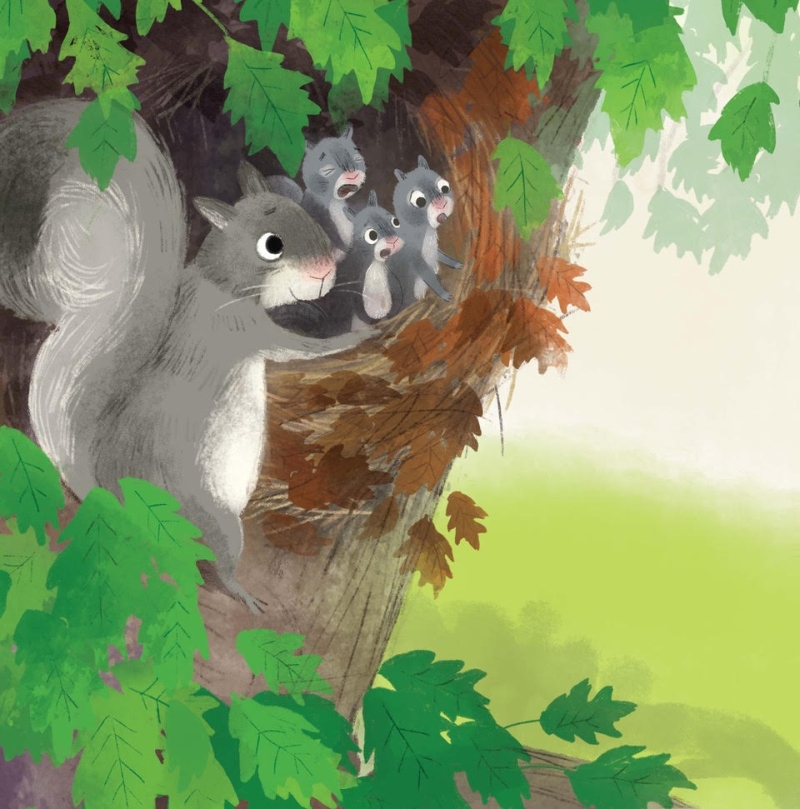
Illustration © Alison Friend
Poetry Break Related poetry to recite before or following the reading of this book
Poetry breaks fit perfectly into brief moments in the day—from opening or closing the day to lining up for lunch; from zipping up backpacks and jackets to transitioning from one subject to the next. Reading a poem typically takes less than a minute, yet it can introduce or reinforce a concept, provide clarity, celebrate language, exemplify rhythm, enhance vocabulary, expand understanding, increase attention span, initiate reflection, spark imagination, or simply summon a giggle. With an emphasis on rhythm, rhyme, and letter sounds, poetry bolsters reading and writing skills. As if that isn’t enough, poetry also soothes and strengthens the spirit.
Select poetry books that pair well with This Is the Tree We Planted:
- Behold Our Magical Garden: Poems Fresh From a School Garden by Allan Wolf, illustrated by Daniel Duncan
- If This Bird Had Pockets by Amy VanDerwater, illustrated by Emma J. Virján
Perfect for Earth Day reflection:
- “The Snail and the Coffee Cup” by Audrey Day-Williams; Friends & Anemones by the Writers’ Loft Authors & Illustrators
And Then There’s This…
Enrichment activities, related books, online resources, craft projects, and ideas for further study
Earth Day is April 22!
Plant a tree, a bush, or a garden on the school grounds.
Take a nature walk and observe the trees. Carry along the list of at the back of the book. How many do you observe? What else do you see?
Blue Dot Kids Press will plant a tree, via a partnership with One Tree Planted, for each child who participates in their Earth Day activity.
Related Books of Interest
- The Adventure of the Big Fish by the Small Creek by Judy Bradbury, illustrated by Gabriella Vagnoli
- And the Bullfrogs Sing: A Life Cycle Begins by David L. Harrison, illustrated by Kate Cosgrove
- Happy Springtime! by Kate McMullan, illustrated by Sujean Rim
- How To Say Hello to A Worm: A First Guide to Outside by Kari Percival
- I’ll Take Care of You by Maria Loretta Giraldo, illustrated by Nicoletta Bertelle, and translated from Italian by Johanna McCalmont
- Kids Fight Climate Change: 60 Missions to Help Save Our Planet by Martin Dorey, illustrated by Tim Wesson
- Listen to the Language of the Trees: A Story of How a Forest Communicates Underground by Tera Kelley, illustrated by Marie Hermansson
- My Tree by Hope Lim, illustrated by Il Sung Na
- Old Enough to Save the Planet by Loll Kirby, illustrated by Adelina Lirius
- Our Planet! There’s No Place Like Earth by Stacy McAnulty, illustrated by David Litchfield
- This Is the House That Jack Built by Simms Taback
- To Change a Planet by Christina Soontornvat, illustrated by Rahele Jomepour Bell
- We Are Water Protectors by Carole Lindstrom, illustrated by Michaela Goade; Caldecott Medal
- The Wisdom of Trees: How Trees Work Together to Form a Natural Kingdom by Lita Judge
- Wonder Walkers by Micha Archer; Caldecott Honor
- Browse the SCBWI’s Recommended Reading List for April with the theme of Celebrate the Earth.
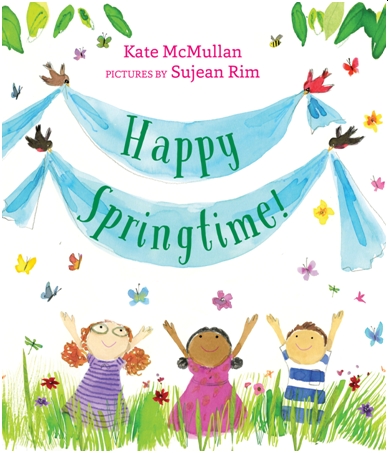
Meet the Author

Kate McMullen
Kate McMullan is the author of the popular Dragon Slayers’ Academy chapter-books and Myth-o-Mania, the Greek myths as told by Hades. For new readers, she’s written Fluffy, the Classroom Guinea Pig, as well as the Pearl & Wagner books. Pearl & Wagner: One Funny Day received a Geisel Honor. With her husband, noted illustrator Jim McMullan, she created a series of picture books featuring talking vehicles. I STINK!, their homage to a New York City garbage truck, was named one of the Ten Best Picture Books of the Year by The New York Times. Kate and Jim live in New York City near Central Park, where Kate likes to spend time getting to know the park’s birds and trees. Find out more on Kate’s website.
Backstory: Q & A with Kate McMullen
It has been my pleasure getting to know Kate as we worked on this post. She is as delightful and energetic as her children’s books. She has sparkle and wit, and is truly passionate about honoring our Earth. See below for details on her school visit Earth Day initiative.
Judy Bradbury: How did you come to write This Is the Tree We Planted? What seeded its creation? (Pun intended and achieved.)
Kate McMullen: A few years ago, Jim and I moved from Sag Harbor, a village on Long Island, to the Upper Westside of Manhattan, and I discovered Central Park, my new backyard. I became an avid birder, and to find birds, one has to know where to look. I learned that some birds are attracted to the berries on certain trees. Other birds go for the insects that are eating the berries. Still others eat tiny critters in tree bark or seeds the tree drops onto the ground. It became clear to me that trees are key to providing food for birds, as well as for squirrels and raccoons and insects. Trees also provide shelter and a relatively safe place for birds to build a nest and raise their chicks. Lots of schools encourage their students plant a tree in honor of Earth Day, and I wanted to share with kids the idea that a single tree, just like the one they may be planting, supports many lives.
JB: The text begins with one line that’s repeated and gradually builds to a satisfying crescendo. Key words are placed in ALL CAPS throughout the book, and toward the end there’s a vertical list recalling the many lives that are part of a tree. Tell us about how you developed the rhythm and beat of the text and how the book’s design was conceived.
KM: The story really begins with the art on the title spread showing a man, presumably a teacher, digging a hole for a tree planting, and kids on the dedication page bringing a hose so they can water it in. On the next three pages, I repeat the line This is the TREE while the art shows the little kids who planted the tree growing bigger and bigger, just as the tree is growing.
I lifted the rhythm of the text from “This is the House that Jack Built.” I tried other ways to get into the concept, but the cumulative nature of this old English nursery rhyme seemed just right for cataloging all that was happening in the tree. The capped words are for emphasis. I capped these words in the first draft. TREE is capped, of course, being the main character in this story, and then the NEST, EGGS, and the names of all the birds and animals that interact with the tree.
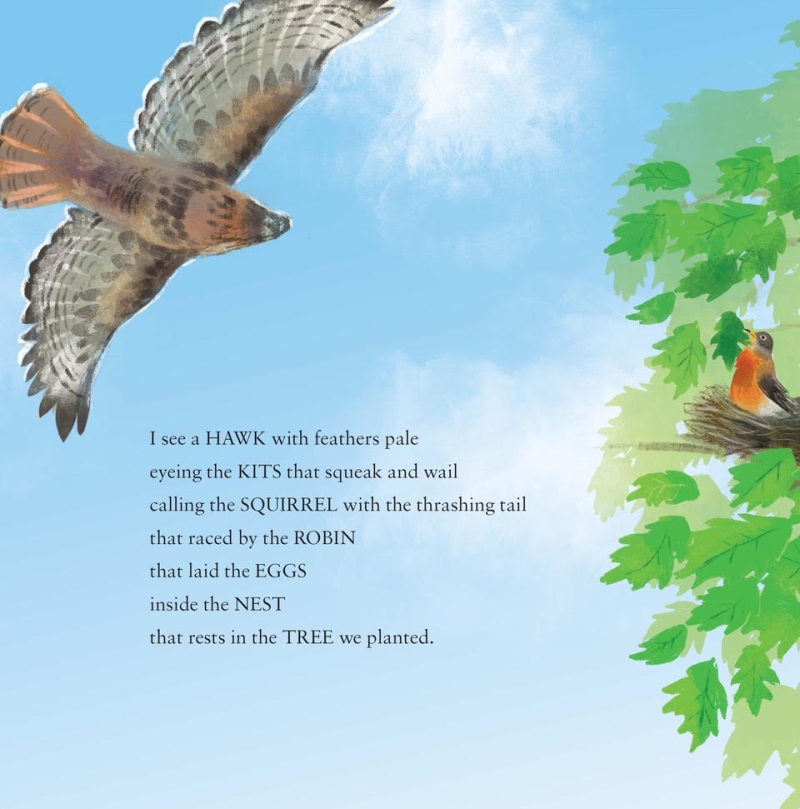
Illustration © Alison Friend
JB: You distill each “part of the tree” to a simple, single, but active line that offers young listeners information while also entertaining them. How did you decide what to include as part of the tree?
KM: Everything I wrote about the tree and the birds and animals had to be true. When I had a final draft, I asked Tod Winston, a naturalist, and a wonderful leader of bird walks for NYC Audubon, to consult with me on the book to make sure it was accurate. He was very helpful. The tree in the book is a Red Oak, and Tod knew exactly which birds and insects would be likely to find food from this species of tree. The rhythm and rhyme of the text determined that each featured player would have only one line.
JB:Tell about one hurdle you experienced in writing This Is the Tree We Planted or provide a memorable (or humorous!) anecdote related to the making of this book.
KM: The -ail/-ale rhyme scheme was something of a hurdle. The rhyme is part of the fun, but there are only so many –ail or -ale words, so it was limiting as well. The squirrel starts it off with its thrashing tail and then the squirrel kits squeak and wail. I was happy to describe the Red-tailed Hawk’s feathers as pale, a nod to a famous Central Park Red-tailed Hawk known as Pale Male. Each spring, Pale Male and his mate nest and raise their brood on the same tall apartment building on Fifth Avenue, and clearly visible from Central Park. Local hawk experts believe that Pale Male is about 30 years old, extremely old for a hawk. His current mate is called Octavia because she is said to be his 8th one.
This wasn’t a hurdle, but Alison Friend, whose gorgeous art graces This Is the Tree We Planted, is English. Birds in England and those in America don’t always look similar. The American Robin was named for the red-breasted English Robin, but they are VERY different! Alison did her research, however, and her birds are all accurate and beautiful.

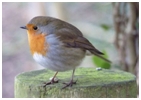
JB: What would surprise readers to learn about you or about the writing of This Is the Tree We Planted?
KM: When I’m lucky, the characters in my books will begin “speaking” to me. I can hear them inside my head and then my job is to write down what they have to say. It doesn’t always happen, but when it does, it makes writing feel like flying. Fluffy the Classroom Guinea Pig was a big talker and I had such fun writing books with him! Hades, the narrator in the Myth-o-Mania series, also spoke to me. It took me a while to convince the garbage truck in I STINK! to let me hear that truck voice, but finally it happened. Since none of the birds or critters in This Is the Tree We Planted have speaking parts, it didn’t happen when I wrote this book.
JB:What do you hope young listeners will take away from This Is the Tree We Planted?
KM:One take-away I’d hope for is that kids would begin to understand that there’s more to a tree than just leaves, branches, a trunk, and roots. There’s also an incredible amount of life going on in a tree, day and night, and if they look, they will see it.
JB:How do you see This Is the Tree We Planted connecting to curriculum or being used in schools?
KM: I’m always awed by the ideas that teachers and librarians come up with for using my books with their students. I’m hoping that This is the Tree We Planted might inspire teachers to have their students plant something in celebration of Earth Day. If there’s room for a tree, fantastic. If not, a native flowering plant may attract the interest of some birds, butterflies, and bees. Students may enjoy keeping a Tree Diary by observing what’s going on in a single tree and writing a sentence or two about it each week throughout the school year. Who knows what kids might see if they really look? Birds, squirrels, butterflies, and changing leaves. The more kids learn about nature, the better stewards they’ll be of our earth.
JB: Many of the Children’s Book Corner blog subscribers are educators. Tell about the Authors 4 Earth Day initiative and your participation in it.
KM: Authors for Earth Day was developed by several children’s book authors who visited schools to talk about their books. They figured out that a great way to help kids learn about conservation and helping the earth would be to donate a portion of their honoraria for that day to a conservation organization, and to let the kids decide which organization should get the donation. and have the kids decide which organization should get the donation.
Here’s how it worked:
A couple of months before the day of my school visit, I’d send the librarian a list of five conservation organizations. The kids would research each one, on a grade-appropriate level, and then advocate for the one they liked best. The whole school would vote on which organization should get the donation, and the winner would be revealed on the day of my visit.
On that day, when I entered a school, I’d often find the hallway walls lined with wonderful posters the kids had drawn with messages like: HELP THE WHALES! Or SAVE THE HONEYBEES! Or DOLPHINS NEED YOUR HELP! Usually, the librarian or the principal giving morning messages to all the classrooms would reveal the winner and I’d hear cheering. I always made a big copy of the check that I’d send to the winning organization to show the kids. Having the kids choose the winner was a great learning experience for them and they absolutely felt empowered by it. A real win-win-win activity.
Eventually, the people who’d founded Authors for Earth Day felt that it took too much of their time keeping the website updated and such, and they were ready to move on, and so the organization no longer exists. But I always felt I could do it school by school on my own, so that’s what I did for a couple of years. It seemed too much to try to do this with virtual school visits, but I’m hoping to get back to it one of these days.
JB:What can your fans look forward to next? What project are you currently working on?
KM: Right now I’m working on a series for maybe 2nd/3rd graders called HAWKEYES about the adventures of some young birders. Birds are endlessly fascinating to me and I’d love to pass on this fascination to kids. And — every single bird you see, even the pigeon pecking pizza crust on the sidewalk, is a real, live dinosaur! Fascinating, right?
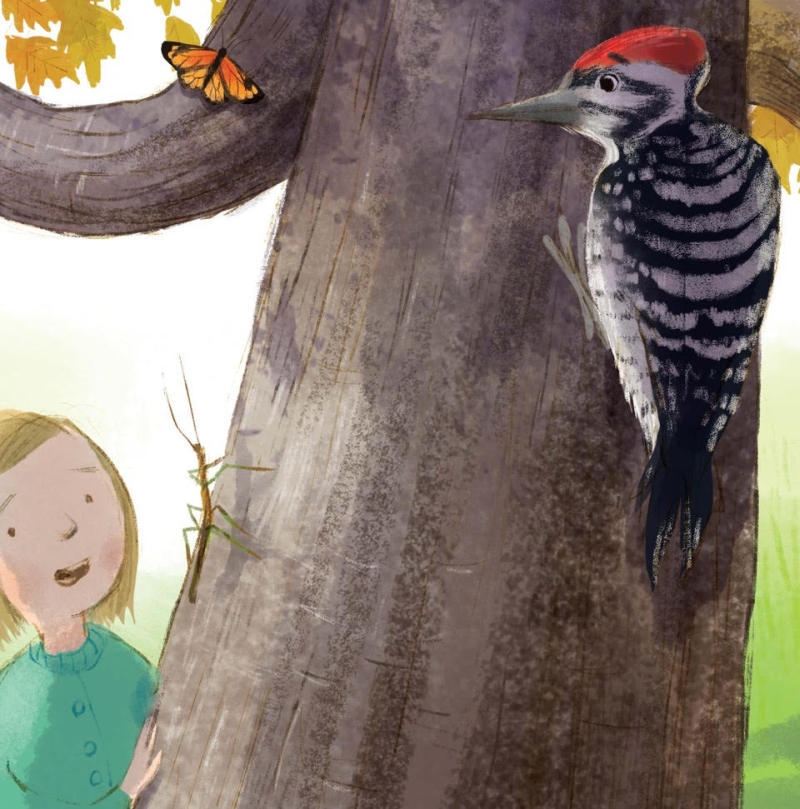
Illustration © Alison Friend
Sidebar Spotlight New releases of note
Each month I receive several boxes of books to review from various publishers. As I read and peruse the books, I place them in two piles: those that I will consider featuring on the blog, and those that don’t fit the mission or theme of Children’s Book Corner blog for whatever reason. I highlight some of the books in the “possible” pile on Mondays (most weeks) on Instagram. Ultimately, I have to choose the one new release I will feature on my monthly blog post. Yet there are many terrific books I wish I could give a shout-out to, even if I can’t write an entire post about each one. So, Sidebar Spotlight is a means of giving a nod to new releases that, in my humble opinion, are noteworthy. I’ve linked each title to Bookshop so you can learn more. Happy reading, friends! And feel free to comment below.
Continuing the celebration of National Poetry Month, consider the following notable new poetry releases and resources:
-
- Marshmallow Clouds: Two Poets at Play among Figures of Speech by Ted Kooser and Connie Wanek, illustrated by Richard Jones
- Out of This World: Star-Studded Haiku by Sally M. Walker, illustrated by Matthew Trueman
- Take Off Your Brave: The World through the Eyes of a Preschool Poet, poems by Nadim (age 4), illustrated by Yasmeen Ismail. Book trailer
- Zoobilations! Animal Poems and Paintings by Douglas Florian
- A listing of middle grade and YA novels-in-verse selected by School Library Journal
- See also this previous Children’s Book Corner blog post.
- A look at how middle grade and YA verse novelists connect with readers
- During National Poetry Month, BirdNote is sharing recordings of nature-inspired poems written by contemporary authors.
News & Updates
Book 3 in the Cayuga Island Kids series, The Case of the Messy Message and the Missing Facts, hits the shelves on May 15! View the book trailer. Learn more about the book and read the advance praise. Find more reviews on Goodreads.
I am honored to return to the Writing and Illustrating blog as the featured author on May 1 to discuss my writing journey for The Case of the Messy Message and the Missing Facts.
Pre-order an inscribed copy from the publisher and receive free shipping, too!
Find news and information on my upcoming events.
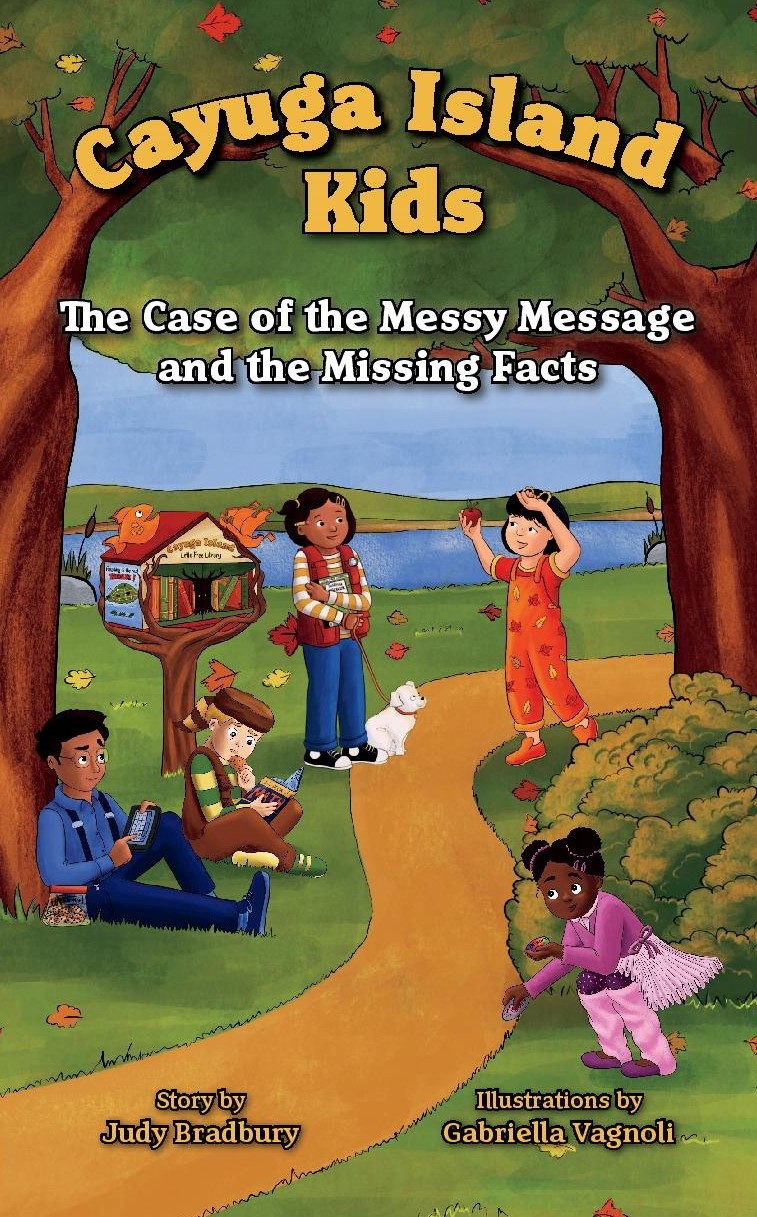
Book 3 in the Cayuga Island Kids chapter book series
Are you familiar with Shepherd? On this bibliocentric website, authors who write across genres and age levels share “their favorite books around topics and themes they are passionate about,” delving into why they recommend each book. The site creators endeavor to offer visitors “an experience like wandering around your favorite bookstore but reimagined for the online world.” Browse by topic, book title, or author. Check out this recent post by children’s author, Marsha Hayles.
Final Thought
“Spring drew on…and a greenness grew over those brown beds, which, freshening daily, suggested the thought that Hope traversed them at night, and left each morning brighter traces of her steps.”
~ Charlotte Brontë

